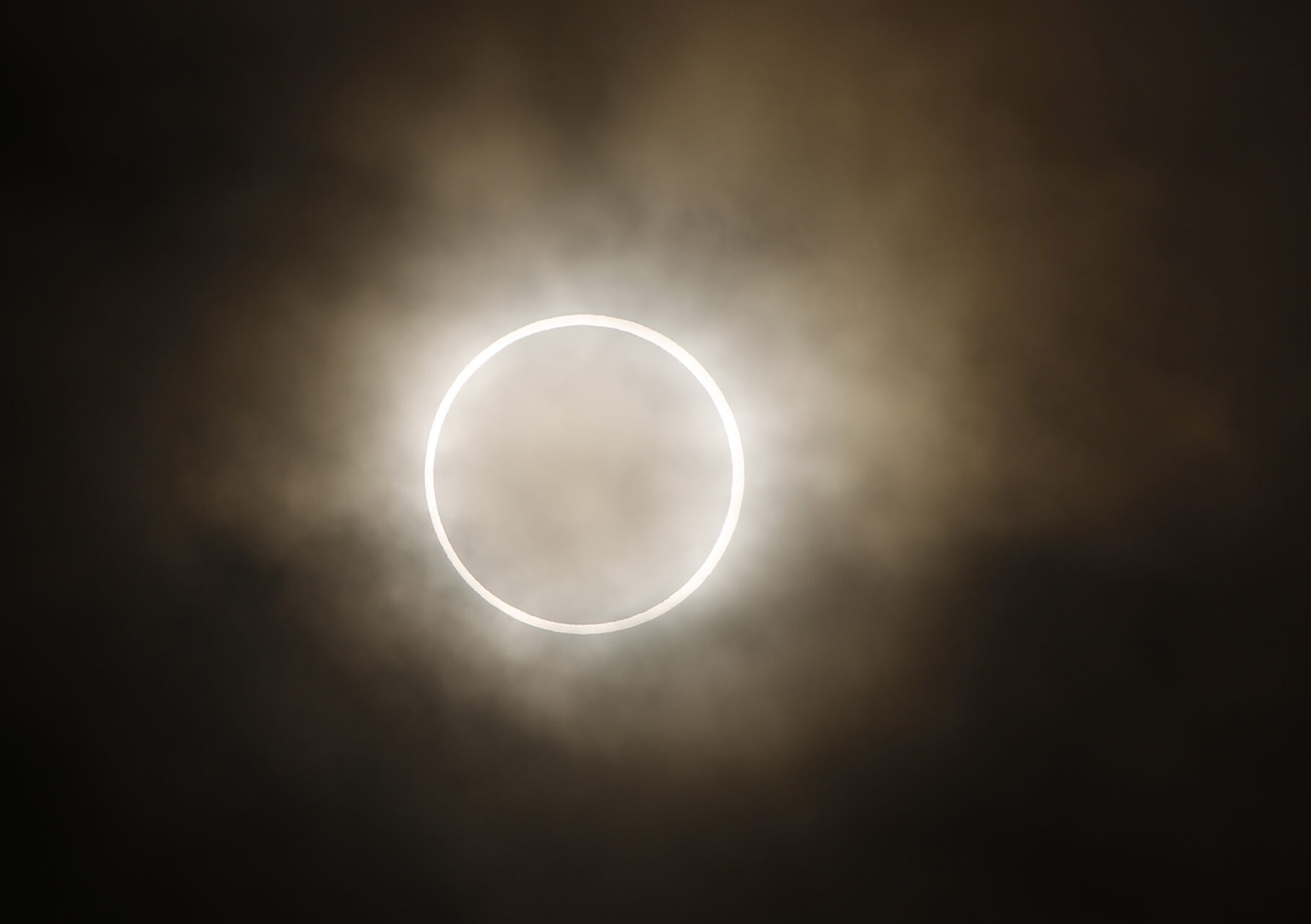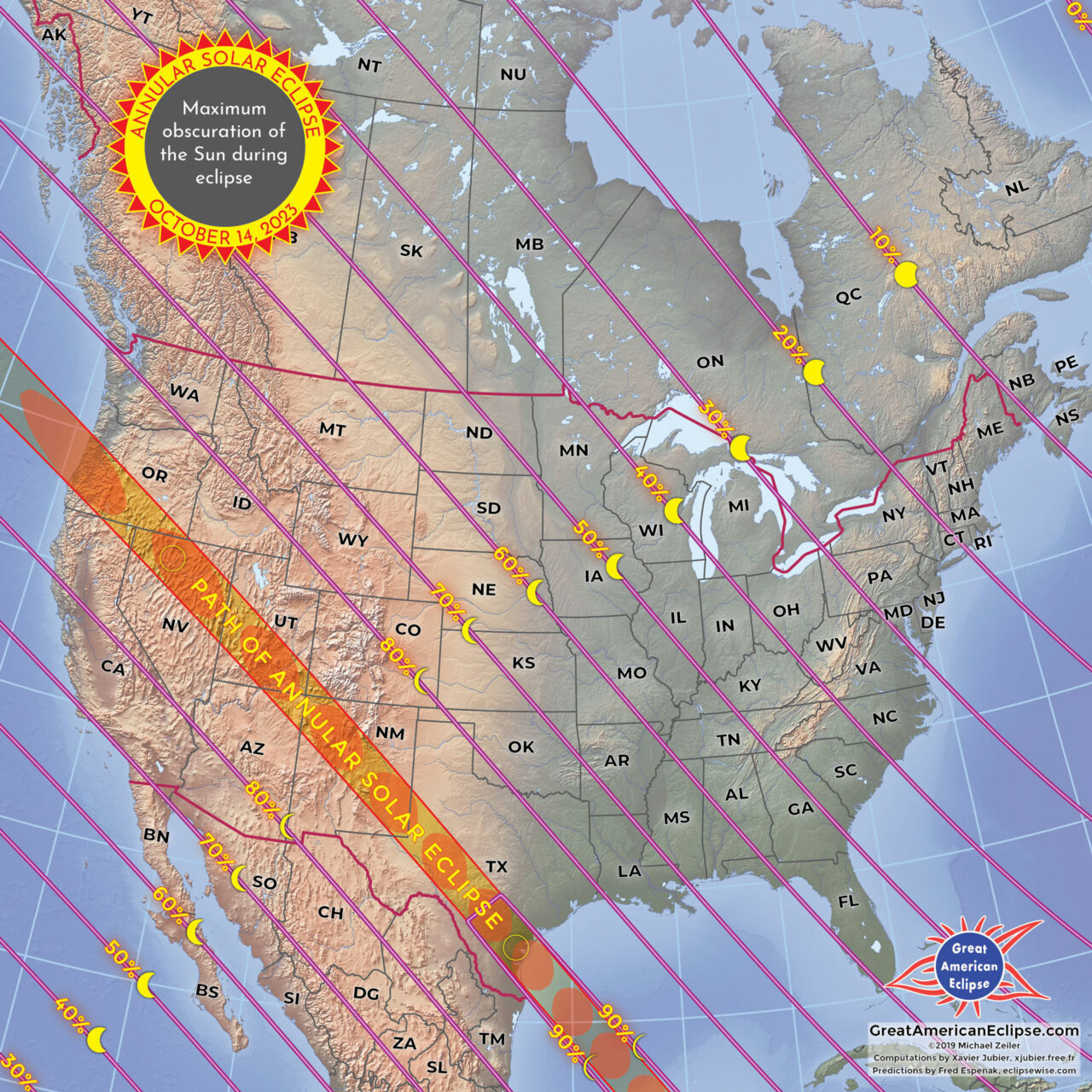
On Saturday, Oct. 14, an annular solar eclipse will grace Utah skies. The full eclipse will be visible from the many state parks in central and southern Utah located in the eclipse zone.
Denise Stephens, associate professor in the Department of Physics and Astronomy, explained that an annular eclipse occurs when the moon is at its farthest distance from Earth and then crosses in front of the sun, partially covering it.
“So there’ll be a ring of light from the sun that’ll be around the moon as it goes across the center,” Stephens said. This unique shape is what has earned the eclipse its “ring of fire” moniker.
Although annular eclipses are a fairly common phenomenon and occur about twice a year, their shadow path changes locations all the time, which means sometimes they are only fully visible somewhere in the ocean or the Antarctic, Stephens said.

This month’s annular eclipse includes many Utah locations such as Goblin Valley State Park, Edge of the Cedars State Park Museum and Kodachrome State Park in the full eclipse zone. The complete list of state parks in the eclipse’s path and their associated events can be found on the Utah State Parks website.
Because the entire state of Utah is in the eclipse’s path, it will be visible from nearly anywhere in the state. Outside the full eclipse zone, however, only a portion of the moon will be seen covering the sun, and the ring of fire will not be totally visible.
The annular eclipse will begin around 9 a.m. MDT Saturday, Oct. 14 when the moon first “touches” the sun and will end around noon when the moon has passed the sun completely, Stephens said. The totality of the eclipse, the portion when the ring of fire is visible, will occur between 10:26 a.m. and 10:31 a.m. according to NASA’s website.
“Unless you are an eclipse chaser, and you put yourself in the path … it’s something that most people will only see once in a lifetime if they see it,” Stephens said of the celestial event.
Stephens emphasized how unique eclipses are, and said she will never forget her experience of the total eclipse that passed through Idaho in 2017, which she said was “life-changing.”
Although this Saturday’s annular eclipse will not feature the completely dark sky and temperature drop that results from a total eclipse, Stephens thinks this annular eclipse is worth taking the time to experience.
Benjamin Boizelle, faculty advisor for the BYU Astronomical Society, believes there is something special about people experiencing the natural phenomena they have read about in textbooks firsthand.
As a young astronomy student, Boizelle and his friends would marvel when they looked through a telescope and observed the stars and planets. Now as a trained astronomer, Boizelle still experiences the same awe. Witnessing the 2017 total eclipse prompted Boizelle to consider the historical and scientific context of an eclipse.
“We can appreciate the advances in science that have allowed us to understand what is happening while also understanding what previous generations have felt and experienced,” Boizelle said.
For Boizelle, seeing the eclipse in person will bring science to life for the viewers.
The BYU Astronomical Society will be promoting the eclipse this week at their informational booth located just outside the west entrance of the Eyring Science Center. Students can visit their booth on Oct. 12 and Oct. 13, anytime between 11 a.m. and 2 p.m.
Michael Holland, BYU Astronomical Society president, said the upcoming eclipse is a rare event and feels as if it is the club’s duty to spread the word.
“It’s part of our responsibility as the astronomy club to put on these public events and to raise awareness for these astronomical events,” Holland said.
The Astronomical Society will also host two solar eclipse planetarium shows at the Royden G. Derrick Planetarium on campus on Oct. 13 at 7 p.m. and 8 p.m. If the weather permits, they will also host a deck star party afterward. More information about the society’s activities can be found on their website.
Holland and fellow Astronomical Society members will be passing out solar glasses on a first-come, first-served basis during this week’s events.
Stephens explained these eclipse-viewing glasses are proofed for solar observation as they block almost all the light from the sun, protecting the eyes. She emphasized that, during an annular eclipse, it is never safe to look directly at the sun with the unaided eye. Thus, glasses or other viewing devices are required to avoid severe eye damage.
Solar glasses are typically inexpensive and accessible but, as the eclipse approaches, can be difficult to find. To remedy this, Stephens is selling glasses at a small cost.
“We’re just trying to get them into people’s hands so that they can look at the eclipse safely,” Stephens said, pointing out that the lack of proper equipment could deter people from even trying to view the eclipse. Students and community members interested in purchasing a pair of glasses from Stephens can find more information on The Expanding Frontier’s website.
When purchasing glasses from other suppliers, interested viewers should verify the glasses comply with the safety standards. A list of certified suppliers of viewing devices can be found on the American Astronomical Society’s website. NASA’s website offers annular eclipse safety tips for the whole experience, including an indirect viewing method in the case that glasses are no longer available for purchase.
Audrey Lofthouse, an environmental science student from Colorado Springs, has known about the Oct. 14 annular eclipse since 2017. After viewing the total lunar eclipse in 2017, Lofthouse compiled a list of all the upcoming eclipses and was excited to see Oct. 14’s annular eclipse would be totally visible from Utah.
“I was like, okay, this one is in Utah, so I’ll just drive a couple of hours south to see it,” Lofthouse said.
Lofthouse encourages all those who are still deciding whether or not to travel to see the eclipse to make the trek.
For those traveling to central Utah, Snow College is organizing a viewing event open to the public on the Snow College Richfield Campus fields. The activity will have hands-on activities, free glasses while supplies last and telescopes and binoculars for viewing.
The Utah Department of Transportation is expecting heavy traffic delays the weekend of the eclipse because of people traveling to and from the full eclipse zone and advises travelers to plan accordingly.
Those who intend on viewing Saturday’s eclipse are encouraged to get their solar glasses soon and hold on to them for the upcoming total eclipse in April 2024, which will not be visible from Utah.
The next eclipse passing through Utah is not expected until August 12, 2045. It will be a total solar eclipse and its path can be found here.




